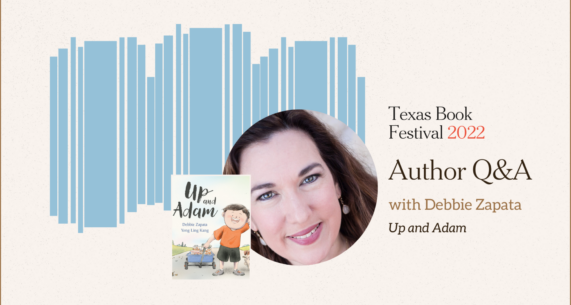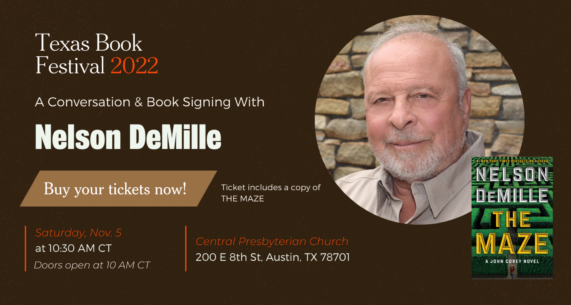The Texas Book Festival Celebrates Black Literature! For the month of February, the Texas Book Festival is celebrating Black History Month by highlighting black Texas authors, readers, and notable contributors to the literary community in a series of blog posts. Last week, TBF Community Ambassador Peggy Terry shared a fantastic list of books coming out in 2018 that she recommends reading, and today, award-winning children’s author and illustrator Don Tate has taken the time to answer some questions we had for him. In addition to being an award-winning author and the illustrator of numerous critically acclaimed books for children, Austinite Don Tate is an outspoken advocate for diversity in publishing, a founding host of The Brown Bookshelf, a Texas Book Festival author, and a long-time TBF supporter and volunteer.
When you’re finished reading here, we recommend you check out the fantastic kid lit blog The Brown Bookshelf, “a blog designed to push awareness of the myriad of African American voices writing for young readers, with book reviews, author and illustrator interviews.” The Brown Bookshelf’s “28 Days Later” series for Black History Month features interviews with large number of amazing black authors and illustrators of children’s, middle grade, and young adult literature.
Happy reading!
Texas Book Festival: What draws you to Children’s literature? Was writing for kids a conscious choice or more the age group you felt inspired to speak to?
Don Tate: Early in my career, I worked at an educational publishing company. My job was to design and illustrate children’s basal books and teaching proucts. The job required some travel to library and literacy conferences. I was inspired by teachers and librarians, who were passionate about children’s literacy. I wanted in on that! Eventually, I illustrated a book for that publishing house called Retold African Myths, written by Eleanora E. Tate. That was thirty-something years ago, and I’ve never looked back. I love using my art to tell stories for young people. Writing came much later, though—like twenty years later!
TBF: I know you’ve written about how, as a kid, you were drawn more to art and drawing than to reading (largely because of the terrible lack of black representation in literature when you were growing up). But how did you first get into art and illustration?
DT: I’ve been an artist as long as I’ve been on this earth. There wasn’t a moment when I accidentally discovered that I liked art. As a child, my hands were always busy drawing and making stuff. I made things like choo-choo trains and cars from empty toilet paper rolls. I created elaborate puppets from socks or from patterns I created. I created macramé wall hangings from twine and beads. I always had some kind of project in the works. Thankfully, my mom supported my artistic endeavors, even when it meant tearing the house apart and putting it back together. I attended a vocational-technical high school. My core area of study was commercial and advertising art. While there, I became less interested in creating art for art’s sake, though. I liked creating art for a specific purpose: a magazine layout, a t-shirt design, a story! I liked commercial art, or narrative art.
TBF: What’s your illustration process look like? How does that compare to your writing process?
DT: My illustration and writing process are similar. When I visit schools, I tell kids that writing is similar to painting a picture. With a picture, I use a paintbrush, a pencil, or some other drawing tool. When I write, I paint with words. I create worlds using very visual word choices.
With my illustrations, I begin with a rough draft. Same with a written manuscript. The first draft of an illustration or a manuscript is messy. But that’s okay, that draft is like a lump of clay that I can then mold into a story. Because my books focus on history, writing and illustrating both require a lot of research. And before any of that reaches my editor’s eyes, I revise my words and illustrations many times.
TBF: What sort of stories do you look for in your writing and/or illustrating? What are some of the elements that you were drawn to in past books you’ve written and illustrated?
DT: I like stories about little-known people who’ve done great things in the face of adversity. These stories inspire me. In my book, It Jes’ Happened: When Bill Traylor Started to Draw (Lee & Low), which I wrote, a homeless man and former slave with no art training becomes one of the most important outsider artists in the country. In Poet: The Remarkable Story of George Moses Horton (Peachtree), which I wrote and illustrated, an enslaved poet becomes the first African American in the south to get a book published, at a time when it was against the law to teach a black man to read. With Strong as Sandow: How Eugen Sandow Became the Strongest Man on Earth (Charlesbridge), which I also wrote and illustrated, a weak and sickly child grows up to become known as the Father of Bodybuilding and “The Strongest Man on Earth.” These men overcame great obstacles to achieve success. These stories inspire kids to work hard and never give up.
TBF: Tell us about your work on the kid lit blog, The Brown Bookshelf:
DT: The Brown Bookshelf was started by YA authors Varian Johnson and Paula Chase-Hyman. They wanted to start an online initiative to support African American children’s book creators, whose works often fly under the radar of the publishing industry. I was invited to join a whole team of writers and illustrators to contribute to the blog. Together, we work to shine a light on the myriad of diverse voices creating books for young people. February is when we host our “28 Days Later” campaign, where we highlight an African American book creator each day of the month with interviews and guest post. Be sure to check out our 2018 campaign!
TBF: I know you do a lot of school visits and events with kids: what’s it like getting to meet your audience like that? What’s one of the best stories that’s come out of interacting with your young readers?
DT: I love meeting my young readers. While they are excited about meeting me, I am equally as excited to meeting them. I’m thankful to school librarians for bringing us all together—authors and illustrators and readers. I’ve had a lot funny and interesting experiences while visiting schools, however one of the most memorable moments happened this past October at the Texas Book Festival. Students at Brushy Creek Elementary School in Round Rock sang a tribute to me and my book Strong as Sandow:
The kids sang a song about me and my books! And look at that librarian in the front! Don’t tell me librarians don’t matter—yes, yes they do! pic.twitter.com/e3dfFldqWr
— Don Tate (@Devas_T) November 6, 2017
TBF: What advice would you give to young authors and illustrators of color? What encouragement?
DT: Polish your craft. Writers: Read and write a lot. And stop worrying about having to find an illustrator, that’s what publishers do. Illustrators: Draw a lot, practice. There is more of an emphasis on diversity in publishing lately, so opportunities are broadening. I’m seeing more faces of color on the covers of children’s books, lately. Most times, however, the creators of those books are not People of Color. Everyone is answering that call for more diversity, so we’re easily marginalized. So, Author or Illustrator of Color—get to creating, your voice is needed. While it’s important for a Black child to see Black people represented in the books they read, it’s equally important that they know Black people write and illustrate the books they read. They know this by opening that book jacket flap and seeing a book creator that looks like them.
TBF: What, at least to you, is the best part of writing for kids?
DT: Supporting literacy. Knowledge is power, and therefore books are powerful.
TBF: What are you working on now?
DT: I have several books on the publication horizon that I illustrated:
Par-tay! Dance of the Veggies (and Their Friends)
Written by the legendary Eloise Greenfield and published by Alazar in April, 2018.
Stalebread Charlie and the Razzy Dazzy Spasm Band
This book, written by Michael Mahin and published by Clarion in July, 2018, is the fictionalized account of the true story seven homeless street kids who helped inspire a new genre of music called spasm.
No Small Potatoes: Junius G. Groves and His Kingdom in Kansas
Written by Tonya Bolden and published by Knopf in October, 2018.
So that’s it for me this year—dancing kids, dancing veggies, and potatoes galore!











